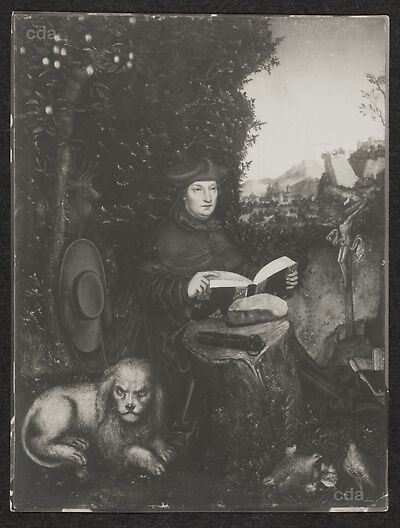Cranach's Portrait of Albrecht von Brandenburg as Saint Jerome in a landscape is an icon of Northern Renaissance art. The picture is rare surviving evidence of the relationship between Albrecht von Brandenburg, the supreme Catholic dignitary of the age, and Lucas Cranach, an artist often described as Martin Luther's foremost propagandist. Thus, the story of this portrait brings together three titans of the Reformation whose inextricably entwined destinies shaped this period of European history.[...]
Never was Albrecht more prone to extravagance than when fashioning his own public image. In 1519, Albrecht Dürer received the extraordinary sum of 200 florins and 20 yards of damask to produce an engraving of the cardinal (fig. 1). By contrast, Dürer's contemporaries Bernard van Orley and Conrad Meit, respectively court painter and court sculptor to Margaret of Austria in Mechelen, earned the modest annual salary of 18 florins (G. Messling, ed., Cranach et son temps, Paris, 2011). Albrecht particularly favoured the 'historiated' portrait, the portrayal of a contemporary patron in the guise of a religious or mythological figure, which became increasingly popular during the Reformation. Albrecht had himself included in the guise of Erasmus, his personal saint, in The Meeting of Saint Erasmus and Saint Maurice painted by Matthias Grünewald (fig. 2).
There are four surviving portraits of Albrecht in the guise of Saint Jerome painted by Cranach, of which only the present picture remains in private hands. Two of these portraits depict the Cardinal as Saint Jerome in his study (1525, Hessisches Landesmuseum, Darmstadt; and 1526, John and Mable Ringling Museum of Art, Sarasota; fig. 3) in a free adaptation of Dürer's celebrated print of 1514. We are grateful to Dr. Dieter Köpplin for confirming the dating of the present picture to c. 1527 (private communication, May 2013). In both this picture and another from the same year (now in the Gemäldegalerie, Berlin), the saintly scholar, still immersed in his theological reflections, has been transported into a landscape. The verdant background, so carefully rendered in this picture, is, however, more reminiscent of the Saxon forest than the Syrian desert.
By the early 16th century, Saint Jerome had become the embodiment of the exemplary Christian scholar and a role model for humanists. His popularity among erudite circles had been heightened by the critical edition of his collected works that the greatest thinker of the age, Erasmus of Rotterdam, had published in 1516, the Sancti Hieronymi Stridonensis Opera Omnia. In portraying himself this way, the Cardinal was following an already established tradition of cardinals portrayed as Jerome. For example, Jan van Eyck's Saint Jerome in his study (Detroit Museum of Arts) is believed to be a historiated portrait of cardinal Niccolò Albergati.
As the official translator of the Bible into Latin, in its canonical version known as the Vulgate, Saint Jerome was regarded as the custodian of the Gospels' truth and integrity. Luther undertook his own translation of the Bible from Latin to vernacular German, which was first published in 1522, and was deemed invalid by Church authorities. One of his main principles was that every believer should be able to read the Bible without clerical mediation. By the time that this portrait was painted in the 1520s, Albrecht had also produced a translation of the Bible which was embraced by the Roman authorities. Thus by taking the guise of Saint Jerome, Albrecht emphasized his own role as a translator of the Scriptures (Tacke, 2007, op. cit., p. 87).
The tame lion looking out to the viewer is the traditional iconographical attribute of Saint Jerome. It became the saint's lifelong companion after Jerome removed a thorn from its injured paw. The stag is a common Christian symbol and its antlers are often associated with the wood of the Cross and the Resurrection. The younger stag or hind nearby, defenseless because of its lack of antlers, can be seen to represent the vulnerable Christ, at the mercy of humanity. A pair of partridges with their young in the foreground perhaps recall a legend in which partridges would steal eggs from the nests of other birds and then hatch them as their own. Jerome considered the partridge a despoiler of homes. Furthermore, in the writings of Saint Augustine, the partridge was likened to heretics, who adopt those they have not bred, a symbolism heavy with meaning in the context of Albrecht's ongoing struggle with the 'heretic' Luther and his growing number of followers. (For more on animal symbolism, see: H. Friedmann, 1980, op. cit., pp. 132, 288-4; C. Campbell, Temptation in Eden: Lucas Cranach's Adam and Eve, London, 2007, p. 76.) [...]
[Christie's, Auct. Cat. New York 2015, Sale 3707, Lot 117]




